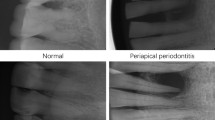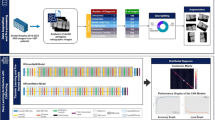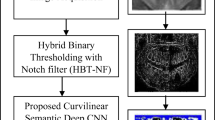Abstract
Dental radiography offers significant indication for medical/clinical diagnosis, quality assessment and treatment. Huge efforts have been taken while developing the digital dental X-ray image analysis system for the enhancement of clinical quality. In this manuscript, the datasets, methodology and analysis of performance are carried out for the evaluation of qualities regarding the dental treatment with the utilization of periapical images of dental X-ray that is taken before and after the operations. With the purpose of supporting dentists to make some clinical decisions, a tool pipeline for automated clinical quality evaluation is being proposed. In this approach, a disease diagnosis from the dental image analysis is made by means of deep learning techniques. Initially, the dental input dataset is preprocessed using bias-corrected filter technique. For segmentation process, semantic contextual network segmentation (SCNS) is employed. The features were extracted using multi-scale local ternary pattern (MS-LTP). Statistical linear discriminant analysis (SLDA) approach is employed for the selection of features. At last, the extracted and selected features outcome is post-processed to improve the rate of classifier performance. The classification process is carried out by means of improved multipath residual CNN (IMRCNN) classifier. Thus, the proposed technique provides better accuracy than others in the diagnosis of dental disease to predict Periapical Disease Detection in Dental Radiographs image. Thus, the disease is predicted so as to diagnose the severity earlier and helpful for dentist in making decisions on treatment process. Thus, finally the performance estimation has been made and the results were compared with existing techniques to prove the effectiveness of proposed strategy.














Similar content being viewed by others
References
Leite AF, Vasconcelos KF, Willems H, Jacobs R (2020) Radiomics and machine learning in oral healthcare. PROTEOMICS—Clin Appl 14:1900040
Schwendicke F, Golla T, Dreher M, Krois J (2019) Convolutional neural networks for dental image diagnostics: a scoping review. J Dent 91:103226
Aliaga IJ, De Paz JF, Vera V, García ÁE, Bajo J (2020) Prediction and failure analysis of composite resin restorations in the posterior sector applied in teaching dental students. J Ambient Intell Humaniz Comput 1–8
Sicuranza M, Esposito A, Ciampi M (2015) An access control model to minimize the data exchange in the information retrieval. J Ambient Intell Humaniz Comput 6:741–752
Raja NSM, Fernandes S, Dey N, Satapathy SC, Rajinikanth V (2018) Contrast enhanced medical MRI evaluation using Tsallis entropy and region growing segmentation. J Ambient Intell Humaniz Comput 1–12
Vellappally S, Al-Kheraif AA, Anil S, Basavarajappa S, Hassanein AS (2018) Maintaining patient oral health by using a xeno-genetic spiking neural network. J Ambient Intell Humaniz Comput 1–9
Al Kheraif AA, Wahba AA, Fouad H (2019) Detection of dental diseases from radiographic 2d dental image using hybrid graph-cut technique and convolutional neural network. Measurement 146:333–342
Geetha V, Aprameya K (2019) Textural analysis based classification of digital X-ray images for dental caries diagnosis. Int J Eng Manuf (IJEM) 9:44–45
Martolia M, Dhanore N, Singh A, Shahare V, Arora N (2019) A modified local binary pattern (LBP) for content-based image retrieval
Jaffino G, Banumathi A, Gurunathan U, Jose JP (2020) Comparison of missing tooth and dental work detection using dental radiographs in human identification. Int J Biomed Eng Technol 32:217–228
Woerner AE, Novroski NM, Wendt FR, Ambers A, Wiley R, Schmedes SE et al (2019) Forensic human identification with targeted microbiome markers using nearest neighbor classification. Forensic Sci Int Genet 38:130–139
Wanat R, Frejlichowski D (2011) A problem of automatic segmentation of digital dental panoramic X-ray images for forensic human identification. In: Proceedings of CESCG, pp 1–8
Souadih K, Belaid A, Salem DB, Conze P-H (2020) Automatic forensic identification using 3D sphenoid sinus segmentation and deep characterization. Med Biol Eng Comput 58:291–306
Cho H, Zin TT, Shinkawa N, Nishii R (2018) Post-mortem human identification using chest X-ray and CT scan images. Int J Biomed Soft Comput Hum Sci the Off J Biomed Fuzzy Syst Assoc 23:51–57
Matsuda S, Miyamoto T, Yoshimura H, Hasegawa T (2020) Personal identification with orthopantomography using simple convolutional neural networks: a preliminary study. Sci Rep 10:1–7
El mehdi EA, Hassan S (2019) An effective content based image retrieval utilizing color features and tamura features. In: Proceedings of the 4th international conference on big data and internet of things, pp 1–6
Jain KR, Chauhan N (2019) Enhancement and segmentation of dental radiographs using morphological operations. In: Dental image analysis for disease diagnosis. Springer, Cham, pp 39–58
Jain KR, Chauhan N (2019) Segmentation of dental radiographs using active contour model. In: Dental image analysis for disease diagnosis. Springer, Cham, pp 59–83
Kavitha G, Muthulakshmi M, Latha M (2019) Image segmentation using contour models: dental X-ray image segmentation and analysis. In: Computational techniques for dental image analysis. IGI Global, pp 62–85
Cheng B, Wang W (2019) Dental hard tissue morphological segmentation with sparse representation-based classifier. Med Biol Eng Comput 57:1629–1643
Author information
Authors and Affiliations
Corresponding author
Ethics declarations
Conflict of interest
The author does not have any conflict of interest.
Additional information
Publisher's Note
Springer Nature remains neutral with regard to jurisdictional claims in published maps and institutional affiliations.
Rights and permissions
About this article
Cite this article
Sankaran, K.S. An improved multipath residual CNN-based classification approach for periapical disease prediction and diagnosis in dental radiography. Neural Comput & Applic 34, 20067–20082 (2022). https://doi.org/10.1007/s00521-022-07556-z
Received:
Accepted:
Published:
Issue Date:
DOI: https://doi.org/10.1007/s00521-022-07556-z




